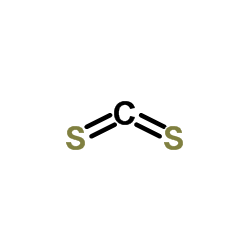Carbon disulphide

Carbon disulphide structure
|
Common Name | Carbon disulphide | ||
|---|---|---|---|---|
| CAS Number | 75-15-0 | Molecular Weight | 76.141 | |
| Density | 1.3±0.1 g/cm3 | Boiling Point | 46.2±9.0 °C at 760 mmHg | |
| Molecular Formula | CS2 | Melting Point | -112--111 °C(lit.) | |
| MSDS | Chinese USA | Flash Point | -18.2±18.7 °C | |
| Symbol |



GHS02, GHS07, GHS08 |
Signal Word | Danger | |
|
Olfactometry Profiles and Quantitation of Volatile Sulfur Compounds of Swiss Tilsit Cheeses.
J. Agric. Food Chem. 63 , 7511-21, (2015) To establish the odor profiles of three differently fabricated commercial Swiss Tilsit cheeses, analyses were conducted using headspace solid-phase microextraction gas chromatography-mass spectrometry/pulsed flame photometric detection and gas chromatography-... |
|
|
Influence of genetic polymorphism on t,t-MA/S-PMA ratio in 301 benzene exposed subjects.
Toxicol. Lett. 231(2) , 205-12, (2014) This study investigated the effect of polymorphic genes GSTT1, GSTM1, GSTA1, EHPX1, NQO1, CYP2E1, CYP1A and MPO on the urinary concentrations and ratio (R) of the benzene metabolites trans,trans-muconic acid (t,t-MA) and S-phenyl mercapturic acid (S-PMA) in 3... |
|
|
Exchange Protein Directly Activated by cAMP (EPAC) Regulates Neuronal Polarization through Rap1B.
J. Neurosci. 35 , 11315-29, (2015) Acquisition of neuronal polarity is a complex process involving cellular and molecular events. The second messenger cAMP is involved in axonal specification through activation of protein kinase A. However, an alternative cAMP-dependent mechanism involves the ... |
|
|
Synthesis and evaluation of glycopolymeric decorated gold nanoparticles functionalized with gold-triphenyl phosphine as anti-cancer agents.
Biomacromolecules 15(10) , 3802-10, (2014) In this study, statistical glyco-dithiocarbamate (DTC) copolymers were synthesized by reversible addition-fragmentation chain transfer polymerization (RAFT) and subsequently used to prepare glyconanoparticles and conjugated glyconanoparticles with the antican... |
|
|
Axial thermal gradients in microchip gas chromatography.
J. Chromatogr. A. 1374 , 216-23, (2014) Fabrication technologies for microelectromechanical systems (MEMS) allow miniaturization of conventional benchtop gas chromatography (GC) to portable, palm-sized microfabricated GC (μGC) devices, which are suitable for on-site chemical analysis and remote sen... |
|
|
Recovery of oxygenated ignitable liquids by zeolites, Part II: Dual-mode heated passive headspace extraction.
Forensic Sci. Int. 240 , 144-50, (2014) Previous studies performed by our research group have suggested that zeolites are a suitable adsorbent for the recovery of oxygenates from fire debris through heated passive headspace extraction. Zeolite 13X, in particular, has been shown to be effective for ... |
|
|
Delivery of an engineered HGF fragment in an extracellular matrix-derived hydrogel prevents negative LV remodeling post-myocardial infarction.
Biomaterials 45 , 56-63, (2015) Hepatocyte growth factor (HGF) has been shown to have anti-fibrotic, pro-angiogenic, and cardioprotective effects; however, it is highly unstable and expensive to manufacture, hindering its clinical translation. Recently, a HGF fragment (HGF-f), an alternativ... |
|
|
Anionic derivatives of uracil: fragmentation and reactivity.
Phys. Chem. Chem. Phys. 16(33) , 17835-44, (2014) Uracil is an essential biomolecule for terrestrial life, yet its prebiotic formation mechanisms have proven elusive for decades. Meteorites have been shown to contain uracil and the interstellar abundance of aromatic species and nitrogen-containing molecules ... |
|
|
Resveratrol prevents tumorigenesis in mouse model of Kras activated sporadic colorectal cancer by suppressing oncogenic Kras expression.
Carcinogenesis 35(12) , 2778-86, (2014) Sporadic and non-hereditary mutations account for the majority of colorectal cancers (CRC). After the loss of adenomatous polyposis coli (APC) function and activation of the β-catenin/LEF signaling pathway, activating mutations in Kras are major drivers of sp... |
|
|
Echinenone vibrational properties: From solvents to the orange carotenoid protein.
Biochim. Biophys. Acta 1847 , 1044-54, (2015) Orange carotenoid protein (OCP) is a cyanobacterial photoactive protein which binds echinenone as a chromophore; it is involved in photoprotection of these photosynthetic organisms against intense illumination. In its resting state, OCP appears orange (OCPo),... |